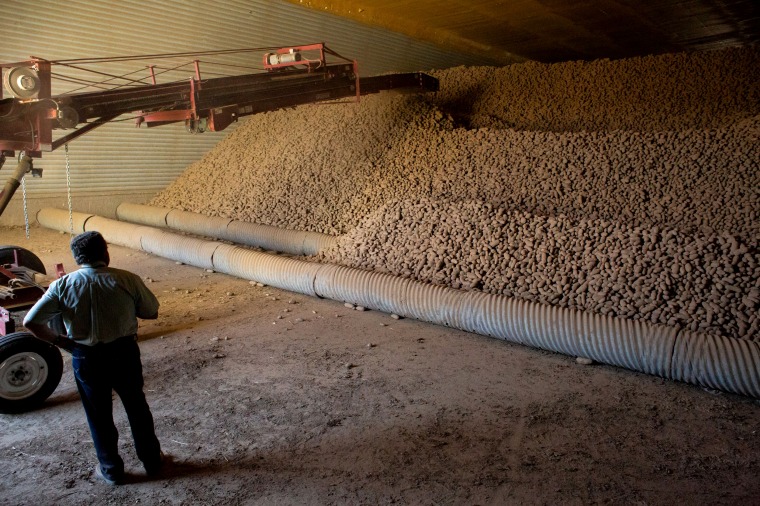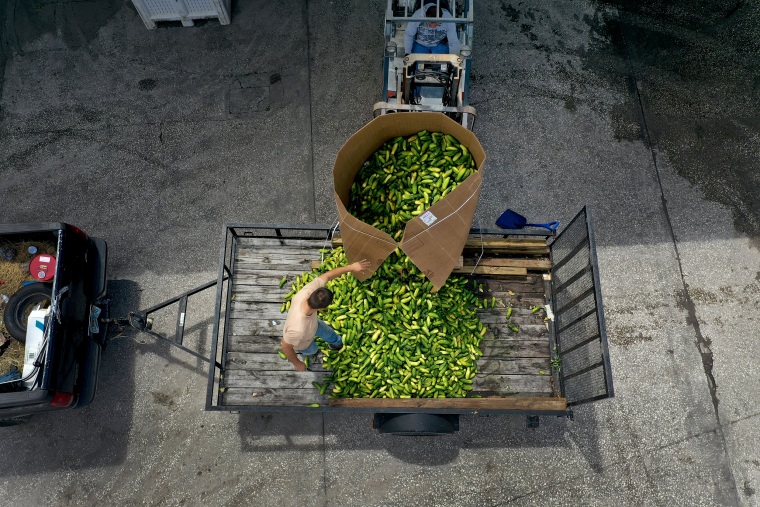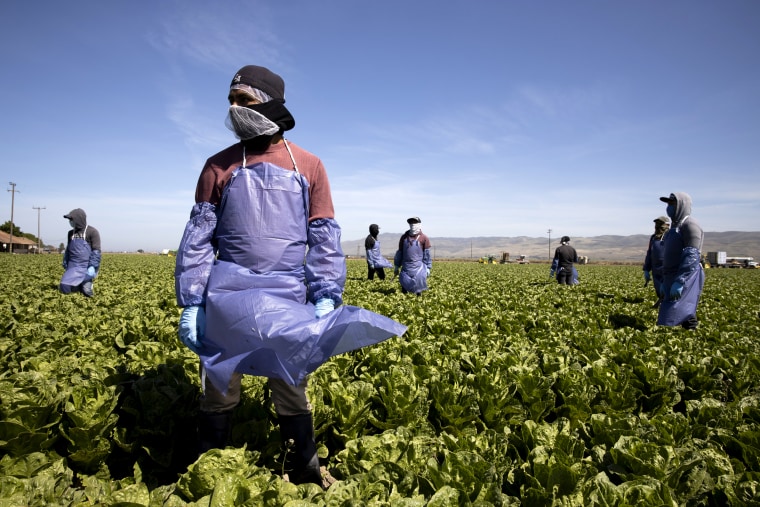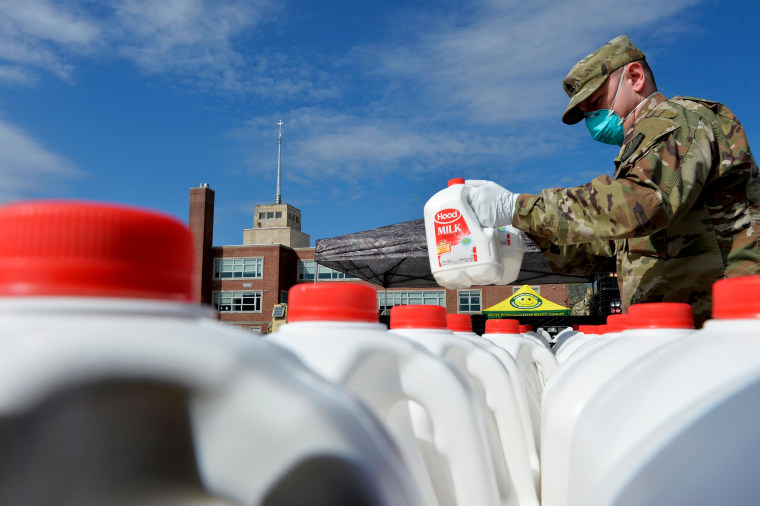U.S. farmers have been battered in recent years by the trade war with China and extreme weather. They hoped 2020 would be an improvement. Then came a pandemic.
The coronavirus shuttered restaurants and schools and sickened meat plant workers. As demand for some goods has plunged and commodity prices have tumbled, farmers are dumping milk and euthanizing pigs and chickens. Industry estimates of agricultural losses for the year had risen to $40 billion by early May, according to a recent Congressional Research Service report.
The federal government has earmarked $36 billion to help U.S. agriculture cope with losses caused by COVID-19, and over half the farmers in a recent national survey said they meant to apply for some relief. On Tuesday, the Department of Agriculture announced the details of the largest slice yet, a $19 billion bailout called the Coronavirus Food Assistance Program.
Individual farmers who have suffered price declines of five percent or more due to market disruptions between mid-January and mid-April will get $16 billion of the money, the USDA said. Applications open in a week, and payments will be capped at $250,000 per person or entity, though corporations, LLCs and limited partnerships may qualify for exceptions. Fifty-eight specific commodities — from barley to lamb to sunflowers — are eligible, though USDA says more could be added later.
Farmers have been waiting to learn which crops are covered and how payments will be calculated for over a month — an eon for dying businesses, but an instant by policymaking standards. USDA’s answer is necessarily complicated; the formula differs across sectors, mixing and multiplying metrics like losses, inventory, and 2019 production value, among others.
”You could go back to Lincoln, there’s no president that’s treated the farmers like Trump."
“No other president’s done this,” said President Donald Trump in remarks about the program on Tuesday. ”I’ll tell you, you could go back to Abraham Lincoln, there’s no president that’s treated the farmers like Trump...These payments will compensate farmers for losses related to the global pandemic, caused by China.”
The initiative comes on the heels of other recent “ad hoc” aid aimed at farmers — most notably, the two trade war bailouts, worth a total of $28 billion, and the Paycheck Protection Program (PPP) COVID-19 relief loans. But these quick-fix programs to get cash to farmers have tended to come with complications, critics say.
PPP logistics proved confusing and difficult for some farmers, and the trade war package has been criticized for overcompensating big farms and politically valuable constituencies. There will be winners and losers this time as well, experts say, as farmers compete for a slice of a pie that will never be big enough.
“A key challenge in coronavirus aid is that, so far, the amount of money is not near enough to cover losses that have happened to agriculture,” Nathan Hendricks, an agricultural economist at Kansas State University, said. “There’s going to be a lot more competing when there’s really limited dollars.”

Behind the scenes, members of Congress and lobbyists for interest groups have been vying for their say on how the money is spent. At least 170 organizations and companies have lobbied the Agriculture Department on matters concerning COVID-19, according to the Senate's Lobbying Disclosure Act Database. In letters to Secretary of Agriculture Sonny Perdue, requests went beyond just the food supply chain; hay and straw sales are suffering due to racetrack closures, cotton and wool are down with the retail market, and decreased travel and gasoline demand reportedly helped put half of ethanol plants offline. Not everyone will be happy with Tuesday’s announcement; some commodities named as needing help — from catfish to craft beer, chicken to sod — are not eligible for direct payments in USDA’s initial list.
“Farmers, just like everybody else, are frustrated by watching markets disappear, watching the economy spiral,” Veronica Nigh, an economist at the American Farm Bureau Federation, said. “They’re aware USDA doesn’t have enough money at their discretion to make them whole.”
The same thing happened during Trump’s trade war bailouts, which have since been subject to bipartisan criticism for benefitting foreign companies and were investigated by the U.S. Government Accountability Office. In a separate review, USDA’s inspector general found the program used a “reasonable methodology” that “was applied consistently across commodities.”
Still, most of the program’s funds found their way to the largest and most profitable farms, the Environmental Working Group found. Researchers have also calculated that corn and soybean producers disproportionately benefited in 2018, and that cotton and sorghum producers got payments that were substantially higher than the trade war’s actual price damage in 2019. And while payment rate formulas were public, an NBC News Investigation found that there was no ‘specific’ or ‘exact’ formula in determining which crops were deemed eligible for direct payments — why cranberries got subsidies, and wild blueberries did not, for example.
“One would think we could learn something from the trade war programs,” said Joseph Janzen, an agricultural economist at Kansas State University who conducted research on the 2019 bailout. “It was not necessarily equitable across commodities and regions. If we make policy using the same process, it seems likely that there will be issues of equity again.”
In a statement to NBC News, USDA said it has been transparent about how it formulated payment rates for the trade war bailout, noting it used a methodology often employed in World Trade Organization arbitrations.
“The fact of the matter is that USDA has provided necessary funding to help farmers who have been impacted by unjustified retaliatory tariffs,” a USDA spokesperson said in a statement. “While criticism is easy to come up with, we welcome constructive feedback from any member of Congress with recommendations as to how the program could be better administered.”
The coronavirus package may be even more logistically daunting than its trade war predecessors, experts say. USDA must continue to evaluate COVID-19-related losses for crops that aren’t even planted yet—and standardize their formula as much as possible across diverse goods like tangerines, hogs and hard red spring wheat, among other commodities covered in the initial list. Some beneficiaries—for example, farmers of more niche fruits and vegetables — may lack experience with USDA’s subsidy processes compared to their peers in wheat and corn. USDA may also face a moral hazard issue, where farmers may be incentivized to overreport losses, the Congressional Research Service noted.
USDA said it worked to build the program “from the ground up, evaluating impacts of COVID-19 throughout the agricultural and food sector.”
“[We] reviewed the resources we had available to do the best we can with what we have,” a USDA spokesperson wrote in a statement. “The topline numbers released are estimates based upon that process and clearly do not account for all the possible losses that have occurred. This is intended to be an inclusive program and more information will be provided in the rulemaking. As we implement and get applications, we will continue to evaluate impacts and work with Congress as more resources are needed.”
The Coronavirus Food Assistance Program is just a portion of the aid authorized by Congress so far. The Agriculture Department is also poised to spend billions on commodity purchases for households, food banks and nonprofits, for example — including a monthly $100 million to dairy, produce and meat, respectively.
An additional $14 billion from Congress would replenish the ransacked Commodity Credit Corporation — a Depression-era Agriculture Department institution with no staff and no physical presence but $30 billion yearly in borrowing power. The obscure financial institution grants the secretary of Agriculture broad spending powers, which Congress restricted in annual appropriations legislation from 2012 to 2017. The restriction didn’t make it into the 2018 version — allowing the Trump administration to use the purse to fund trade war bailouts. As a result of the trade war bailout, the Commodity Credit Corporation was running unusually low on funds when COVID-19 hit, with just $6 billion in reserves. Along with the Coronarivus Aid, Relief, and Economic Security (CARES) Act, it is now one of the funding sources for the Coronavirus Food Assistance Program.
More spending toward agriculture will come from the Small Business Administration, through Paycheck Protection Program (PPP) funds and Economic Injury Disaster Loans (EIDL). In the first PPP round, 1.3 percent of funds went to agriculture-related businesses. Data for the second round has not yet been released.
The Rural Advancement Foundation International-USA (RAFI), which runs a hotline for farmers, says farmers are flagging common challenges in accessing these new pots of money.

“There’s lots of confusion and lots of concern that I’m hearing from farmers,” Tyler Whitley, a program manager, said. “There’s confusion over who is eligible at SBA, while what’s happening with USDA hasn’t yet been rolled out.”
Reid Phifer, a poultry and row crop farmer in North Carolina, says he approached over half a dozen banks trying to access PPP funds.
“The banks were totally lost,” he said. “They didn’t know how to deal with farmers.”
In correspondence shared with NBC News, Phifer ran into a series of hurdles with various banks — including some where he had preexisting lending relationships. At least two banks denied him because he didn’t have a business checking account, for example, and some bankers weren’t used to working with farm tax forms and farm income records. He says he received EIDL funds last week but is still trying to get his PPP application processed – a process that has now been ongoing for more than a month.
“It’s quite confusing,” he said. “It’s got to work better than this. Farmers have got to farm. If not, you don’t eat.”
More aid to farmers has already been proposed. The Heroes Act, a new $3 trillion Democratic proposal for coronavirus relief, would add $16 billion more in direct payments to farmers; it passed the House on Friday, but Republicans say the bill is dead on arrival in the Senate. House Speaker Nancy Pelosi, D-Calif., said she anticipates bipartisan negotiation on the proposal.
But quietly, several experts are raising concerns about the very premise of the COVID-19 farmer aid — now the third multibillion-dollar program quickly conceived behind closed doors at the Agriculture Department, bankrolled by a shadow corporation with indefinite borrowing power.

“It takes away Congress’s fundamental right to shape spending and shape the farm safety net in a way they see fit,” said Joshua Sewell, senior policy analyst for Taxpayers for Common Sense, a nonpartisan budget watchdog. “I don’t know anybody who thought the Secretary of Agriculture would have that kind of authority. But they did it. They did it twice. And they’re going to do it again.”
“The biggest question moving forward is literally what will happen moving forward,” Nicholas Paulson, an agricultural economist at the University of Illinois, said. “How long do we need to continue with, and how long can we continue with these multibillion support packages each year before we do something different?”
Still, the coronavirus brings a clear consensus: U.S. agriculture needs help, and nobody has time for a multiyear farm bill debate. However, it has also highlighted longstanding fault lines in the food system that are not so easily solved by government cash, such as intense market concentration and farmers’ diminishing share of each food dollar.
“Am I going to use the CARES act?” said Kyle Hemmert, who runs a cattle operation in Kansas. “I’d be a fool not to. Who’s going to turn down government money, especially if you could use it? But I don’t want to rely on government money on a yearly basis, no way. I’d rather see a better system.”

